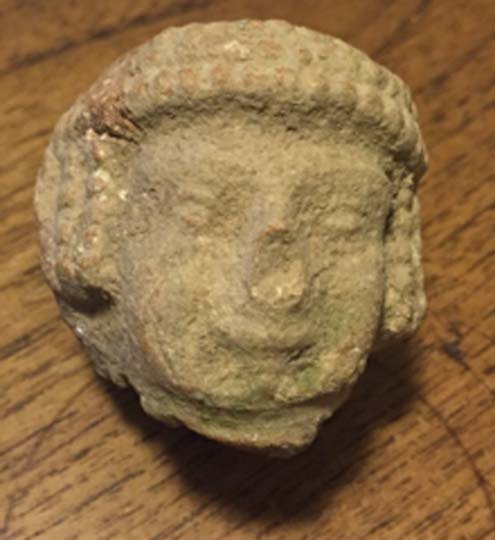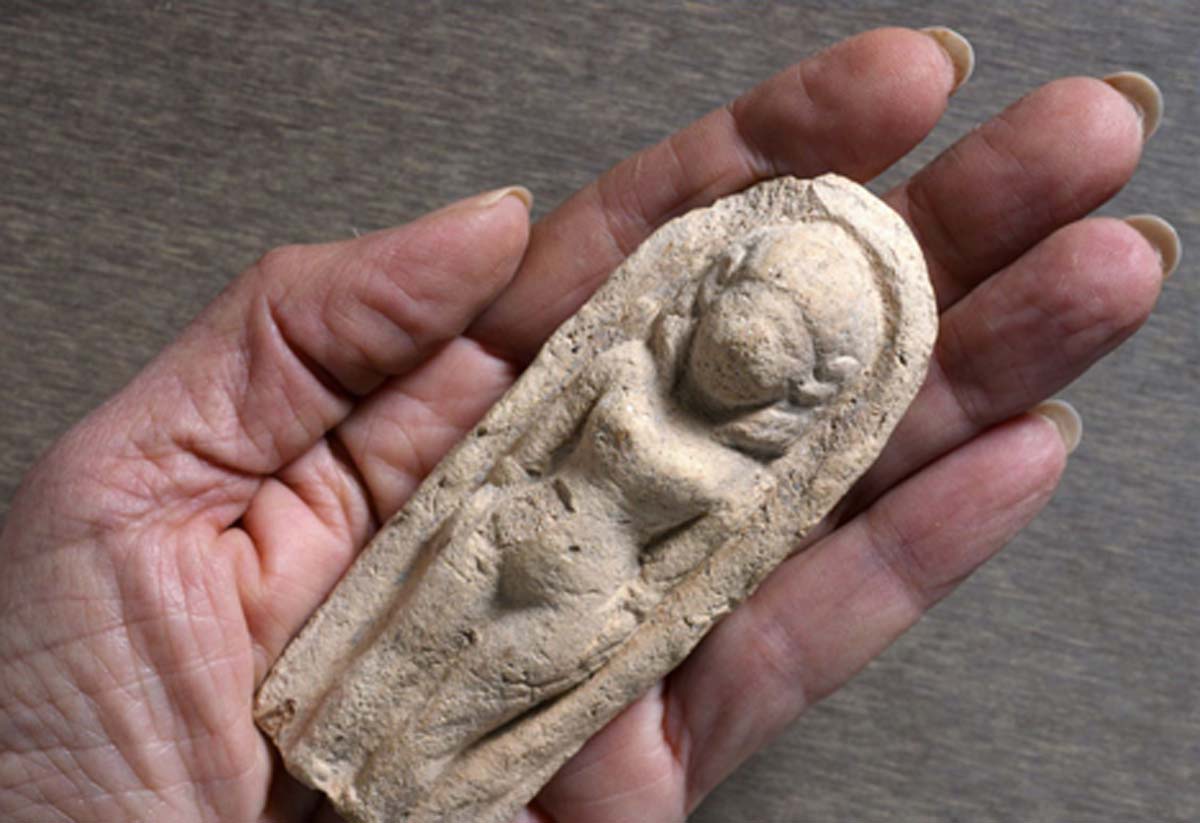Bare Naked Lady Tablets Offer A Fresh Insight Into Ancient Canaanite Goddess Worship
Five clay tablets depicting full-breasted naked ancient Egyptian women and a carved scarab have been unearthed by archaeologists digging at Rehob, a 3,500-year-old city in modern-day Israel.
Mazar and Uri Davidovich are archaeological professors at the Hebrew University of Jerusalem and they detailed their new findings in a paper published recently in the Bulletin of the American Schools of Oriental Research, which you can read here on the University of Chicago website. Tel Reḥov (Reḥob) was among the largest of the ancient Canaanite cities in the southern Levant during the Late Bronze Age (15th–13th centuries BC) and flourished when Egypt controlled much of the region.
Mazar and Davidovich wrote in the journal article that “Rehob was constructed near Beth Shean, a town protected by an Egyptian garrison” and Uri told Live Science that the carvings of the naked women “likely depict ancient fertility goddesses, such as Asherah or Ashtarte”. And attempting to offer a reason as to what practical purpose the tablets might have served Mazar told Live Science in an email that they were “used at home, as part of popular domestic religious practice, in the domestic sphere, mainly related to fertility of women”. We will return to these women momentarily.

A carving found during excavations at Tel Rehov shows a fertility goddess. (Gabi Laron, Tel Rehov excavations / The Hebrew University of Jerusalem)
Inscribed Scarab
The tablets depicting the naked women were found within an “elaborate, large, public structure whose purpose and total size is unknown” and its wide walls and buttresses are framed by a spacious courtyard. Mazar and Davidovich wrote the building has a “large hall to its south, deep foundations, and massive constructional fills all attest to its non-domestic nature”.
Also discovered was a scarab carved from steatite, a talky mineral which consolidates as soapstone, and according to Arlette David from the Hebrew University it contains a “hieroglyphic inscription” which she translated to discover that the scarab had been created for “a deceased man called Amenemhat” who is described as “the scribe of the house of the overseer of sealed items”. While it is not yet known who Amenemhat was, or the significance of the scarab, the reference to ‘sealed items’ is believed to refer to administrative tools.
- Almost 100 Cuneiform Clay Tablets Unearthed and Archaeologists Cannot Wait to Decipher Them
- Serapis: God of Fertility and the Afterlife that United Greeks and Egyptians
- Top Ten Ancient Egyptian Discoveries of 2014

This scarab with a hieroglyphic inscription saying that it was made for a deceased man named ‘Amenemhat’ was found within a large building at Rehob. (Gabi Laron/Tel Rehov excavations / The Hebrew University of Jerusalem)
Interpreting The Fertility Symbols
Returning to the naked women, their breasts are round and full and according to the archaeologists they represent fertility. But what does that actually mean? We know what the word ‘fertility’ means to us today, but what did these naked woman actually represent to the people concerned?
In their world, among the most prevalent social struggles, caused by diet and numerous environmental pressures, was getting and staying pregnant. Fertility goddesses were of course associated with agriculture, but because they were believed to directly influence fertility of the womb they were worshiped by those desiring children, so it could be postulated that these tablets were likely owned by someone wanting a child.
But it wasn’t just the Canaanites who worshiped female goddesses for the Bible tells us: “You shall not make for yourself a carved image, or any likeness of anything that is in heaven above, or that is in the earth beneath”. (Exodus 20:4, ESV). And, furthermore, “Beware lest you act corruptly by making a carved image for yourselves, in the form of any figure, the likeness of male or female”. (Deuteronomy 4:16)

Asherah, Canaanites goddess of motherhood and fertility. (Matanya / CC BY-SA 3.0)
Young Dr. Jones and the Ancient Goddess of Fertility
A slightly later fertility goddess was discovered in 2013 when ‘the young Indiana Jones’ - eight-year-old Itai Halperin discovered the ancient head of a ‘fertility goddess figurine’ when he was walking with his family near Tel Beit Shemesh. This Israel21c article features Alon de Groot, an Israel Antiquities Authority (IAA) expert on the Iron Age, who dated the find to the Iron Age and corresponded it with “the First Temple period in ancient Israel, from the 10th to 6th centuries BC”.

The head of the Iron Age statuette found by an eight-year-old Israeli boy. ( Alexander Glick / Israel Antiquities Authority)
According to de Groot figurines of this kind, depicting naked women symbolizing fertility, were common “in the homes of residents of the kingdom of Judah from the 8th century BC until the destruction of the kingdom by the Babylonians in the days of Zedekiah (586 BC)”. This ceramic statuette head helped the IAA “determine the borders of the area controlled by the kingdom of Judah” which beckons the question: what cultural or societal secrets might these newly discovered naked ladies have in store, beyond the currently obvious fact that they are associated with fertility?
Source: Amihai Mazar, Uri Davidovich, and Arlette David, "Canaanite Reḥob: Tel Reḥov in the Late Bronze Age," Bulletin of the American Schools of Oriental Research 381, no. (May 2019): 000. https://doi.org/10.1086/703205
Top image: This naked lady statuette was found by a 7 year old boy at Tel Rehov in 2015. Source: © Clara Amit, courtesy of the Israel Antiquities Authority.
By Ashley Cowie




















Comments
Strange that carved fertility figurines would fall out of favor at the time of the Babylonian's coming, especially since the Babylonians were known to curse debtors and such with infertility as seen in some of their writings
All of the female figurines made with stone, which have been found almost all over Europe, with prominent breasts and emphasised hips were hand carved during the Age of Taurus they are simply a veneration of the deity which we know today as Venus which rules Taurus. The figurines were mostly hand held enabling the holder to lovingly fondle Venus. Some of the figurines even have a prominent clitoris.
Venus rules feminine beauty and fertility and at the same time rules agriculture which begins the life of our food. The symbol of the female is the symbol of Venus the circle with a cross attached to the bottom of the circle.
Ashtarte or Ishtar said quickly translates into that which we know today as Easter, the period when Venus rules or takes prominence, in the sky as the Son of God moves through Taurus.
The 21st April to 21st May, which before somebody (deliberately and malevolently for a purpose) messed with our months this was day 1 to day 30 of my revered ancestors, month.
At the end of the Age of Taurus the empire of Egypt collapsed as many empires have collapsed at the end of the Age. The Roman empire rose at the end of the Age of Taurus and collapsed at the end of the Age of Aries and as we have just left the Age of Pisces this is precisely that which we are seeing now, the total and complete collapse of the Western civilisation and the rise of the Eastern civilisation.
Nothing will remain.
"..likely depict ancient fertility goddesses, such as Asherah or Ashtarte”. For all of these Middle Eastern people, for whom she was foreign and who were unaware of her origins, she was one of the Æsir. So those people called her Asherah, Ashtarte or Isis. But we know her simply as Freyja
"While it is not yet known who Amenemhat was, or the significance of the scarab"
Freyja means Lady. Scarab = ladybird